These last few winters we’ve tracked down some of those colourful British cyclo-cross stars of the 70’s and 80’s – Keith Mernickle, Eric Stone and Chris Wreghitt have all told their stories to VeloVeritas.
But perhaps the most colourful of them all was the man with the ‘George Best Look’ and the lightest of bikes – Barry Davies.
Barry recently gave of his time to remind us about a time when it all seemed like so much more of an adventure – and more fun…
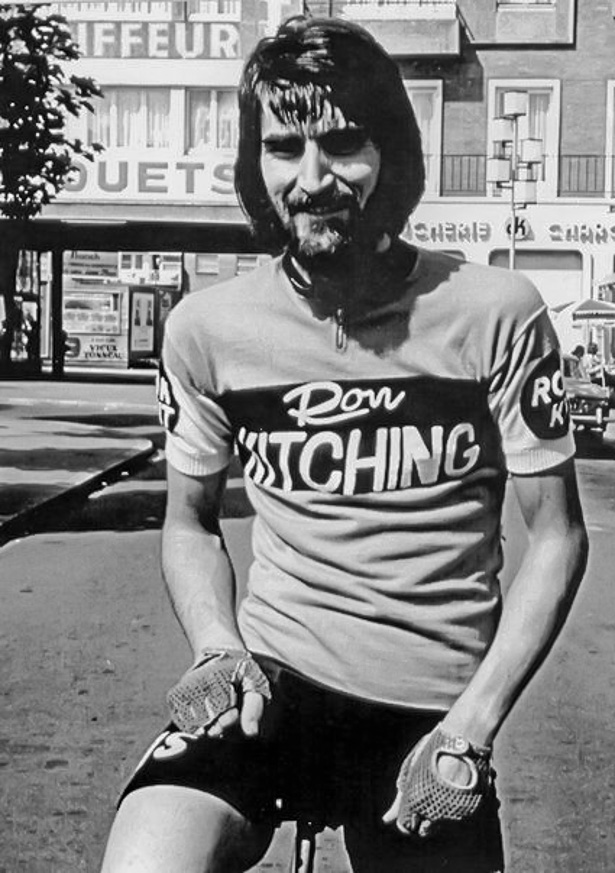
You were a runner, originally Barry – how did you get into cyclo-cross?
“It’s true that when I started cyclo-cross I was known as a runner – but I had a background of cycling too. I was good at cross country running at both school and club level from the age of 13 so it was cross country in the winter months and track running in the summer. Then as an experiment we had two lady teachers at our boys only school.
“One of the ladies was a keen cyclist with the Apollo Wheelers in Manchester. She started to run weekly cycling rides on Saturdays which I started to go on as we all had bikes and used to ride the four miles to school and back.
“Although I was a good at cross country I was never fast enough at 800/1500m so cycling took over during the summer months. This consisted of riding time trials and schoolboy road races in the Manchester area.
“I then discovered that although I was not fast enough for 800/1500m I was fast enough for the 1500/2000m steeplechase race and so my cycling took a back seat.
“I won every title in the UK in 1965 both at schools and club level and was short listed for the Commonwealth Games in 1966 at the 3000 steeplechase.
“Following various training programs issued by AAA coaches did not produce the required results – only injuries. This was the time when running 12 miles a day was the norm.
“I started to ride my bike to see if I could recover from injuries and purely by chance I ended up working with the Shuttleworth brothers – who are still riding cross in the North West Races – they suggested that I ride cyclo-cross.
“So in 1967 I rode the opening race at Flixton – I punctured and did not finish – the next race I was in the top 10 and progressed from there.”
Tell us about ‘the look’, with the hair and the beard.
“As it seems now that every top cyclist has a beard – this was not the case in the 70’s. It was not planned I just hated shaving and having my hair cut! But having a beard and long hair certainly helped especially when racing abroad as it was unheard of – a bit like the bearded lady at the circus!
“I think I was known as ‘the Bearded Englishman’ when contracts were being sorted for ‘cross races.”
You were professional ’68 to ’82 but why the break in the 70’s?
“I rode full time as a pro from 1971 to the end of the 75/76 season and during the winter decided to move from Yorkshire to North Wales where I had spent all of my school holidays. Also my contract was not renewed with Ron Kitching as he did not have a team in 1976 and it was difficult to find a proper pro contract.
“I did not race in 1977 or 1978 as was busy settling down to life in the mountains of North Wales where I still live.
“I returned in 1979 and got in touch with Harry Quinn Cycles, who used to build all my cyclo-cross frames for Ron Kitching. Harry had sold the company and moved to North Wales but I agreed to ride for a team called San Marco Harry Quinn.
“I rode the first race and was second and then third in the Three Peaks so was back to a good level.
“I arranged to go over and get all my bikes and clothing and equipment as agreed, but when I got there – nothing! Not even the guy who I arranged the contract with.
“I rang the BCF the next day and they cancelled the contract.
“I won a big race the next weekend in London and it was all reported in the Cycling Magazine – the race and the contract problems – and I received a phone call from Mr Jack Fletcher of Trumanns Steel to come and ride for his club Team Manchester Wheelers.
“There were no rules under BCCA rules to stop this so I rode the rest of the cross season for Manchester Wheelers Trumanns Steel. The BCF were not happy about this as they did not want pro riders riding for amateur teams – so we ended up changing the team name to Trumanns Steel with Been Bag Clothing as another sponsor for all the clothing.
“I rode till the end of the 1982 season when sponsored clubs took over.”
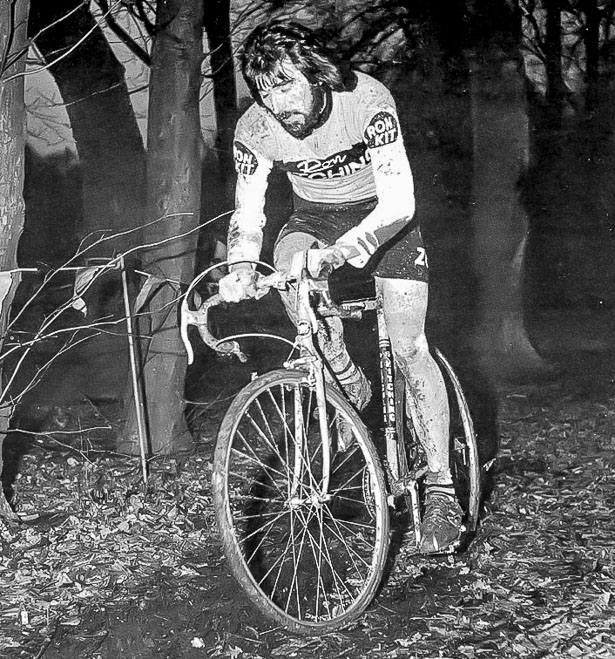
You had a few sponsors in that time – which was best?
“They were all very different – the first, Sports Motors Manchester was where I worked and my boss kept seeing my name in the paper winning races.
“He was interested in cycling having ridden on the track at Fallowfield and was also running the works Brabham Formula 3 racing car in the UK championship which we had won; so he agreed to sponsor me for a year – I think I got £100 for the year.
“But wages were about £18 per week at the time.
“I ended up at Ron Kitching via Harry Quinn – I had ridden for Tower Cycles with Eric Stone for a year but thanks to Harry ended up with bikes built by him with Jacques Anquetil transfers applied via Ron and all the Ron Kitching Milremo equipment on them.
“I rode with a plain jersey with some small Milremo badges on. Some pictures appeared in Cycling Weekly and the BCF threatened to ban me for advertising.
“I spoke to Mr Kitching and he said ‘OK, we better have a team’ which was how the famous ‘Green and Blacks’ Ron Kitching team was formed. Everybody was great up in the HQ at Harrogate with all the best equipment available.
“I rode for Mr Fletcher at Trumann’s for four years but had very little contact with him – he left all the clothing and equipment up to me to sort out; he just enjoyed seeing the results in the papers and magazines.”
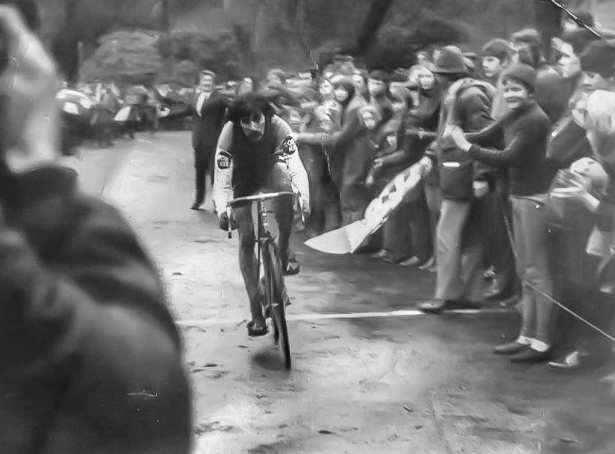
You were the first to get into the superlite equipment – and the first to use a titanium frame – tell us about that.
“When I was first to meet Harry Quinn he told me to bring my existing cross bike with me. It was a 24 inch Carlton as in those days you rode with very little seat pin out. He took one look at it and said ‘I see you like riding on a farmers gate size frame!’
“He then told me to go and ride a 22.5 inch road bike up and down the street – the difference was incredible. So he built the bike like a road frame but slightly longer forks around the fork crown and slightly longer rear end.
“People talk about Colnago in Italy but more top riders rode Harry’s bikes I’m sure – like me – with other builder’s transfers on. He used to love to do the impossible.
“Ron did not really have a good cantilever brake set and I was using Zeus equipment which was great, so he came up with the idea of stripping the callipers down to the two arms and fitting them direct onto bosses on the frame, which worked great – the USA frame builders did the same thing on MTB bikes years later.
“He also weighed the tubing and used a real mixture to build me some light frames – Reynolds 531SL with 531 double butted down tube whilst the back end was a mixture of Columbus/Ishiwata/Vitus whichever was lightest.
“At Ron Kitching I used to weigh everything before building the bike. One of the major things to save weight with was the Zeus 2000 freewheels – made in alloy and like a Swiss Watch inside. I think my racing bikes were something like 19 lbs in weight.
“In 1975 Ron Kitching took on the sales side of Speedwell Titanium framesets that were being made in Birmingham. It was decided that to get some publicity I would use one on my attempt to set a cycling record for the 270 mile Pennine Way here in the UK.
“It all went well till the last 10 miles when the frame broke whilst on the Cheviot Hills. I was very lucky that it was a mile from the only access to the Pennine Way but still had to do a four mile detour and an extra hour to get my spare Speedwell and onto the finish and set the record.”
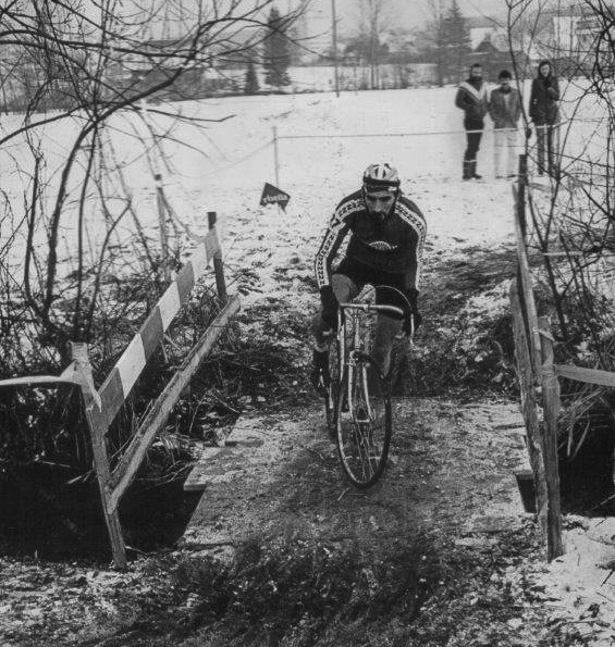
And you were a skin suit pioneer too …
“Yes, the first rider to use a skinsuit in a cyclo cross race – it came about in December 1979 – I had just ridden the North of England Championships on a very muddy course in Keighley and decided to weigh all my muddy clothing in a bucket – the result was almost seven pounds which was ridiculous considering that we were making our bike as light as possible, drilling holes on everything we could.
“Team Raleigh had used some modified skiing downhill suits made by Descente in the Tour de France time trials. I called into Gibbsport in Manchester, who supplied the Manchester Wheelers clothing, and explained my thoughts. Stan Hughes who owned the company opened a drawer and pulled out a Descente skinsuit and said ‘I’ve been dying to make one!’
“By Thursday the ‘suit was finished and by Friday it had been printed up and I raced in it on the Sunday. To say it brought lots of comments was an understatement. The following year we made the change over to Trumanns Steel and Beenbag made the clothing.
“During the summer of 1980 Roberto Visentini had ridden in coloured shorts in a race in Italy and got fined. Molly at Beenbag sent the design for the new Trumann’s kit and there it was with red shorts to match the yellow and red top.
“It looked stunning but when I asked about the black short rule she said that the actual rule said ‘dark coloured shorts’ and red was a darker colour than yellow.
“It was submitted and approved by the BCF so I rode throughout September, October and into November in red shorts – but some blazer wearing BCF person in Manchester was not happy and made official complaints – it went to a high level BCF meeting and they decided shorts had to be black – how times have changed!”
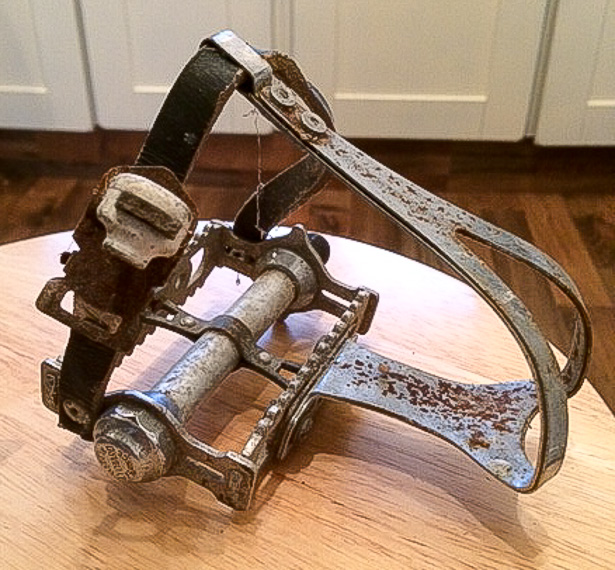
Tell us about pedals and shoes in those pre-clipless days, please.
“It’s hard to remember riding a bike with toe clips and straps on but in the 60/70/80’s that’s what all there was in cross racing. Everybody used the same set up – Lyotard double sided pedals and double toe clips.
“The first thing I used to do was to strip the pedals down, remove the spindle and all the bearings. The area where the foot used to rest was serrated as standard so that had to be filed flat so you could get your foot in quickly. The bearing surfaces were polished and top quality ball bearings fitted and adjusted so you could blow the pedals round they were so smooth. The toe clips were taken apart and the two top sections riveted back together.
“To stop the mud building up inside the pedal the sides the toe strap was cut in half and riveted to the sides of the pedal cage.
“Some people used to add weight to the bottom of the toe clip to allow the pedal to hang further down so getting your foot in was easier.
“As there were no usable cross shoes until Puma brought out its shoe in 1980 everybody had there own ideas – some used running shoes but they were hard to get into the pedals.
“I used cycling shoes with shoe plates with spikes in – I eventually found some light weight football boots with moulded studs on the sole and cut them at 45 degrees so they went into the pedals and fitted alloy shoe plates.
“When the Puma’s arrived you just had to fit some shoe plates onto them.”
Tell us about your training; did you ride road in the summer and were you a full time pro?
“The cross season always finished towards the end of March so all of April was spent trying to return to some form of normal life.
“May was just getting back into training with general running and riding, I’ve always been lucky with great training partners especially when I lived in Holmfirth – the Sydney brothers Graham and the late Granville (perhaps the greatest of the pure specialist hill climbers, winning the National Title six times in the decade between 1963 and 1973, ed.) and top lady runner Jean Lochhead.
“There were fell running races in the Yorkshire Dales and the Lake District which were registered as ‘professional’ as the prizes were always cash.
“There was also the grass track league in Leeds which they allowed me to ride but with no mention of my sponsors.
“I also used to ride most of the UK pro races which were hard but great fun with a great bunch of guys and I was a member of the ‘rear of the peloton’ club.
“I was lucky that with both Ron Kitching and Trumann’s Steel I received a proper paying contract with bonuses and all my equipment rather than the jersey and a bike deal that was quite common, plus when I rode abroad I got really good start money.
“During the summer I was lucky that I had a nice part-time job in a bakery in Huddersfield delivering bread and cakes – Friday was cream cake day yummy!”
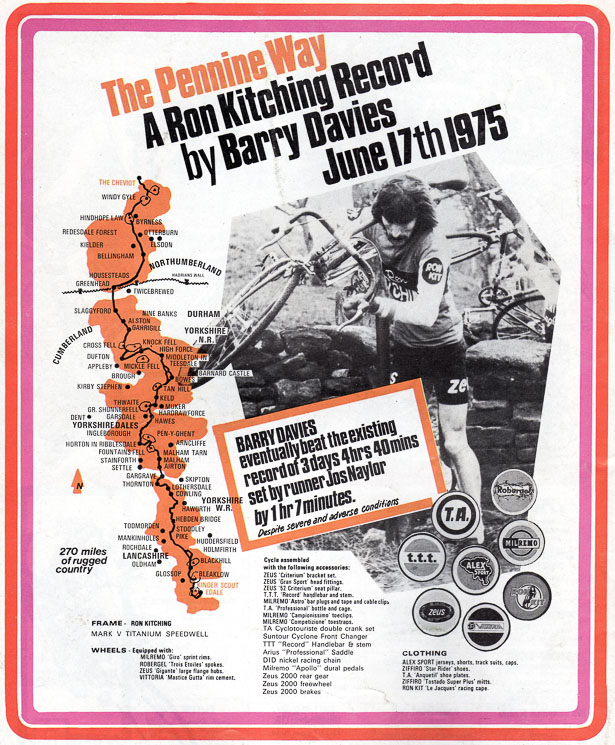
Your National performances never really reflected your true standing – why?
“The GB National Champs were always held at Sutton Park in Birmingham and the course that they chose did not suit me or Eric Stone as there were never any great running sections. The only times that they had them we both did well.
“In 1975 I rode away from everybody and was well in the lead only to get caught up in some course ropes and steel posts that had come undone and caught up in my bike eventually finishing third.
“In 1979 there was a race from there, live on UK TV and I finished third against a top class field. But racing abroad was always a pleasure – Belgium, France, Luxembourg, Switzerland with lots of top ten placings.
“I had two third placings in Belgium in 1974 – at Overijse and Torhout with Roger De Vlaeminck and Frans Verbeeck there.
“I was leading the ‘cross at Lanarvily in Brittany in 1974 with a lap to go and punctured, but when I got back to the pit area all my spares had been taken to the finish. So we were struggling to find a wheel for me to use…
“I must have ridden around 500 cyclo-cross races winning just under 150.”
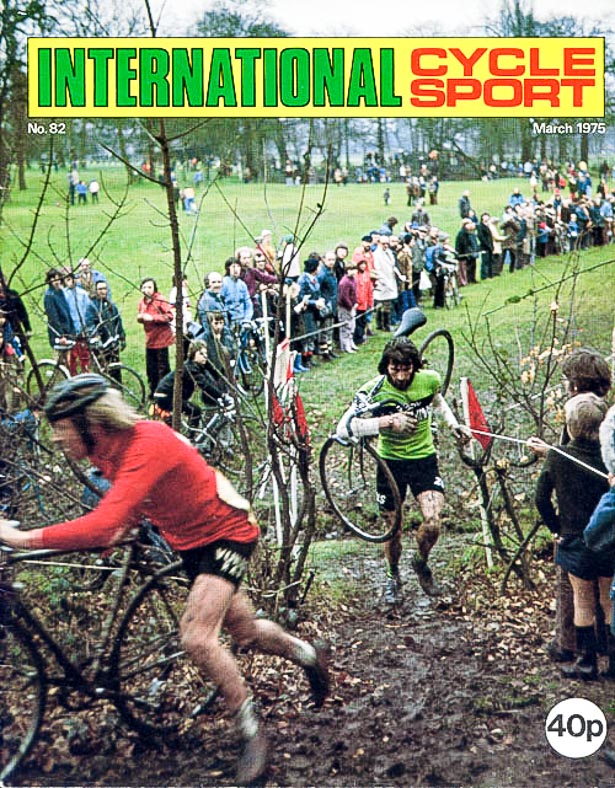
Major Victories?
- “5 x North of England Titles
- 1 x North of England Veterans Title
- 1 x Welsh Title
- 1 x Welsh Veterans title
- 1 x 3rd British Professional Championship
- 3 x Three Peaks Winner
- Pennine Way Cycle record (Still hold the fastest time for actual riding/running time – 48 hours).
“I rode four World Championships – Zolder Belgium; Melchnau and Wetzikon both Switzerland and Bidossa Spain – finishing 14th there.”
Which ride(s) are you most proud of?
“Winning the Three Peaks for the first time was a great personal feeling and also doing the Pennine Way which as I had no idea of the route for most of it – especially around the Scottish Borders, a real adventure.
“In running – setting the 2000m steeplechase record, which although its 50 years ago is still as fast as the present youngsters are doing looking at the English Schools Results and I was running on a cinder track.”
You raced the De Vlaeminck brothers, can we have some memories please?
“The first time I was aware of the De Vlaemincks was on a TV program here in the UK.
“It was called ‘International It’s a Knock-out’ where towns from the UK battled against towns from Europe in silly games and the town with most points then proceeded towards the final.
“One program featured a Belgian village – I don’t know if it was the De Vlaeminck’s home town of Eekloo – but it involved a bicycle obstacle race on a cycle track – Roger and Eric rode and won by a mile. Roger and Eric were like chalk and cheese; Roger knew he was a super-star and behaved like one.
“We would be lined up for a race behind the race officials and Roger would ride up and line up in front of the officials who would then move around him and we would re-form alongside him.
“Eric was just one of the lads, a real character; there are many stories about Eric some true some from the history of cyclo cross folk lore.
“My best is – we were riding a race near Ostend – with lots of sand as always. We set off down a tarmac rode and had to turn off and across the sand dunes. There was a stone wall running alongside the sand dunes on the left. I arrived in the top six onto the dunes and off the bike and running in the sand towards the top of the dune.
“Suddenly the large crowd erupted and started cheering – I looked to the left and there was Eric riding along the top of the three foot high wall laughing at us all struggling, having jumped his bike onto the top of the wall at the bottom of the sand dune.
“There are so many stories of him bunny hopping steeplechase hurdles – riding down a sheet ice decent with his broken handlebar in his hand waving to the crowd a real star.”
How does GB ‘cross now compare to your era?
“With all the BC races being run under UCI jurisdiction there’s a fixed set of rules, and it seems that there’s no room for innovation.
“A lot of the older cross courses cannot be used, we used river crossings, concrete steps etc, and some courses had lots of running too.
“The recent World Cup race in the UK run by Simon Burney was a great ‘old school’ type of race and the National Trophy race at Bradford seems the same. I know a lot of courses do not have running sections which is a shame.
“I heard that someone had complained at a race that they did not like the course as they had to get of their bike!”
Regrets?
“I don’t have any.
“I think I was very lucky to have ridden in the period I did, with such great riders and friends, and great courses, and with the current trend for retro bikes and rides like the L’Eroica now worldwide, seems I rode on some of the finest framesets and bikes made at the time.
“So if I have a regret it’s that I don’t have a single bike that I raced on.”
With thanks to Barry for his time and for sharing is memories with us.



